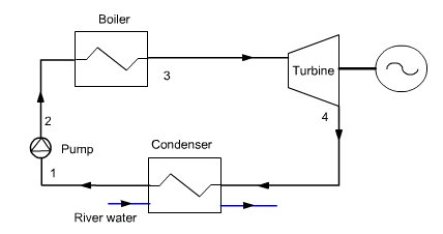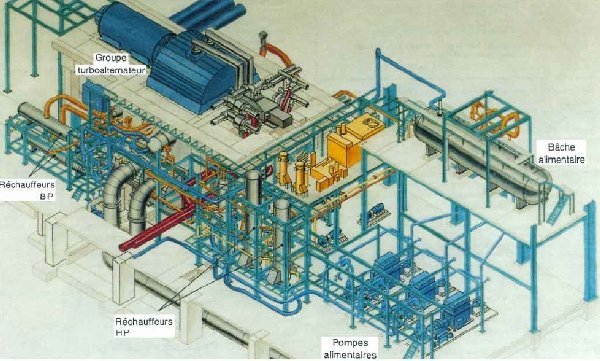Steam power plant cycles
Hirn (or Rankine with superheating) cycle uses a condensable fluid, which is cooled at a temperature and pressure sufficient for it to be fully liquefied before compression. Under these conditions, the compression work is almost negligible compared to the expansion work (although it represents about 60% in a gas turbine). The compressed liquid is vaporized and superheated in the boiler by heat exchange with the hot source, then expanded and condensed. Fluid two-phase state during condensation and vaporization phases is very favorable for heat transfer.
The block diagram of a steam power plant operating on the ideal Hirn cycle is given in figure below. Such a plant includes four basic components:

The pump is generally centrifugal, multistage as it must provide a significant compression ratio.
The boiler has three successive functions and behaves thus like a triple heat exchanger. It must:
heat pressurized feedwater (in the economizer) to the vaporization temperature corresponding to the pressure;
vaporize steam;
and finally superheat steam at the desired temperature.
Figure below shows a 300 MW steam power plant engine room.

Steam turbines are mostly multistage axial turbines. They can be grouped into two broad classes, depending on how expansion is divided between the stator and rotor:
impulse turbines, in which any expansion of the fluid is then carried out in fixed blades or nozzles, upstream of the wheel, and pressures upstream and downstream of the rotor are equal;
reaction turbines, where expansion is then evenly distributed between the nozzle and the wheel.
Each of these two turbine types has advantages and disadvantages of its own: the impulse turbines are generally used for multistage turbine head stages or for small capacity units, while reaction turbines turn out to be well adapted for low-pressure turbines.
The condenser is a heat exchanger whose particularity is to work at a pressure lower than the atmosphere, given the low vapor pressure of water at room temperature. The condensation at 20 °C implies that we maintain a somewhat low vacuum in the condenser (0.023 bar), which requires a complex device for extracting air, given inevitable leaks, especially since it is necessary to use huge low-pressure turbines considering its very low specific volume at 20 °C, which induces very large volume flows, and thus very large flow sections and high velocities.
Note :
Variants of the basic cycle
Cycles with reheat and extraction
The simple Hirn or Rankine cycle we have so far considered is far from being the most efficient, as it differs much from the Carnot cycle, for various reasons. In order to improve it, it is possible to make reheats and extractions as shown in Diapason session S27En .
Supercritical cycles
The optimum technical and economic capacity of flame Hirn cycles until recent years matched with boiler conditions of about 560 °C and 165 bar, leading, with a reheat and without extraction, to a thermodynamic efficiency close to 40%.
To significantly increase the efficiency, it is possible to use so-called supercritical cycles in which water pressure exceeds the critical pressure of 221.2 bar.
Pressurized Water nuclear power plants (PWR)
Another thematic page is devoted to Pressurized Water Reactor (PWR) in which the very low steam superheating requires a specific architecture.
Book references
An excerpt of the textbook chapter is freely downloadable with the agreement of CRC Press
Available Diapason sessions
Diapason sessions dealing with steam power plants are given in the table below. Session S25En is specifically dedicated to technology, while others allow you to build in Thermoptim models of various steam plants:
in session S26En, we study the simplest cycle;
in session S27En the previous cycle is improved by introducing a reheat and an extraction;
in session S28En the exergy balance of the machine is built.
S26En | 27 | 12 mn 35 s | |
S27En | 13 | 8 mn | |
S28En | 6 | 2 mn 50 s |
